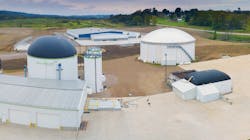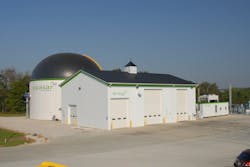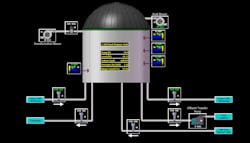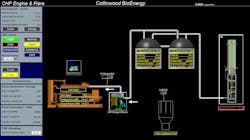Increased demand for renewable resources coupled with rising energy costs and a global movement to reduce greenhouse gases is fueling growth in the anaerobic digestion market. Anaerobically digested waste creates biogas, a renewable energy source used to power engines and generators. Biogas can also be harnessed for vehicle fuel and has similar applications as natural gas. The market is demanding resources to protect the environment and anaerobic digestion is an effective way to do that. Captured methane is an alternative to petroleum products.
According to the World Biogas Association, anaerobic digestion has the potential to reduce global greenhouse gas emissions by more than 13%. Additionally, the market is forecasted to reach $15.3 billion by 2025. Since only 5% of food waste is recycled with the rest ending up in landfills, there is tremendous opportunity for this technology.
Quasar Energy Group Cleveland, OH
Founded in 2006, Quasar Energy Group designs and builds anaerobic digesters – industry-scale machines that convert solid waste such as manure and food processing scraps into methane gas and carbon dioxide. Keeping organic waste out of landfills is beneficial for the environment since decaying materials release methane into the air and contribute to climate change. The company handles everything from manure generated by feedlots to biosolids produced by municipal wastewater treatment plants, and targets the agricultural and wastewater treatment sectors.
Quasar employs engineering, construction, regulatory, and research & development staff to ensure their systems remain on the cutting edge of renewable energy technology. One impetus for Quasar’s growth has been stringent regulations on discharge quality by the U.S. Environmental Protection Agency enacted in 2013. Many treatment plants were having trouble meeting the new limits and securing funding to support necessary capital upgrades. Over the years, the company has entered into private-public-partnerships with municipalities.
Wastewater Treatment Plant Digesters
There are more than 16,000 municipal wastewater treatment facilities in operation nationwide, many needing immediate help in treating the massive amounts of domestic sewage produced.
The energy hidden in wastewater is an untapped resource – especially since only 544 of the 16,000 systems use anaerobic digestion – with the potential to offset 12% of the US electric demand. The country’s aging wastewater treatment infrastructure is facing capital, technical and regulatory challenges. Facilities are progressively required to improve pollutant loading reductions mandated by the Clean Water Act. Upgrading to high solids digesters is an effective way to address these infrastructure improvements without passing the costs on to ratepayers.
Biosolids are pumped into stirred tank reactors, where they can be co-digested with outside organic waste. As anaerobic bacteria break down the volatile solids in the digester, biogas is released and can be combusted to generate electricity. This electricity can be net-metered on site with the potential for the wastewater treatment plant to become a net-zero facility.
The Process
Energy is in the waste stream that goes to every wastewater treatment facility. Quasar capitalizes on the energy that is in the solids’ organic fraction coming into these plants. In anaerobic digestion, complex bacteria breaks down organic matter to produce biogas or a left-over “digestate” used for fertilizer or animal bedding. Multiple organic materials can be combined in a practice known as co-digestion, ideally increasing biogas production from low yielding or hard-to-digest waste.
The process begins with the delivery of liquid or solid organic waste. Liquid material is pumped into underground storage tanks, and solid waste streams are delivered into the hopper where they are diluted and macerated. The material is then pumped into the biomass equalization tank where the breakdown (of material) begins. Incoming waste streams are mixed for three days and then pumped into digester tanks where it is continuously mixed and broken down by anaerobic bacteria for between 18 to 30 days.
Quasar operates with just-in-time logistics, meaning that raw materials are received the moment they are needed and in the exact amount to reduce inventory cost and waste in the supply chain process. Within a water resource recovery facility, the solids receiving, digestion, co-generation and effluent management operate via just-in-time logistics.
Monitoring
Quasar’s Ohio facilities in Cleveland, Zanesville, and Wooster are monitored around the clock by Rockwell Automation’s FactoryTalk SCADA system, which can be controlled on site by plant operators or remotely from Quasar’s central monitoring facility. Integrated with this SCADA system is WIN-911 remote alarm notification software to continuously monitor the alarms and provide important security updates. The software also allows operators and engineers to monitor the system from anywhere using a smartphone or tablet.
Because of the critical nature of their systems, each component is closely monitored to make sure there is not any breakdown. Any unplanned downtime in even one of the machines would be extremely costly as well as detrimental, and the entire process would have to literally start over.
The remote alarm notification software monitors the pressure flows and optimal metrics for the temperatures, tank levels, volumes, pressure and biogas levels in every piece of equipment in the anaerobic digestion process. The system also monitors numerous roof blowers, desulfurization blowers, and pumps. Sensors in the equipment give information to the SCADA system and if there are any problems, the software will notify the plant operators via email and SMS alarms. Quasar will be upgrading to a more robust version of the software to ensure greater consistency.
“Because of the critical nature of the systems, we rely on the remote alarm notification software to monitor almost every aspect of the process,” said Robert Luciano, electrical engineer Quasar. “To help wastewater treatment plants comply with environmental regulations we need to be notified of critical alarms right away so we can respond immediately to any issues.”
Technology Offers Sustainable Future
There are many obstacles wastewater plants face to implementing anaerobic digestion, such as high capital costs associated with building new digesters or upgrading existing systems to meet the needs associated with the addition of other organic streams, such as food waste. Time and funding constraints are other obstacles many facilities and plants contend with when trying to adopt anaerobic digestion.
However, this technology offers the potential for energy recovery and revenue generation. By finding and recovering all that is valuable in wastewater, municipalities can shift to a more sustainable future. A future where current needs are met without compromising the ability of future generations to meet their needs.



